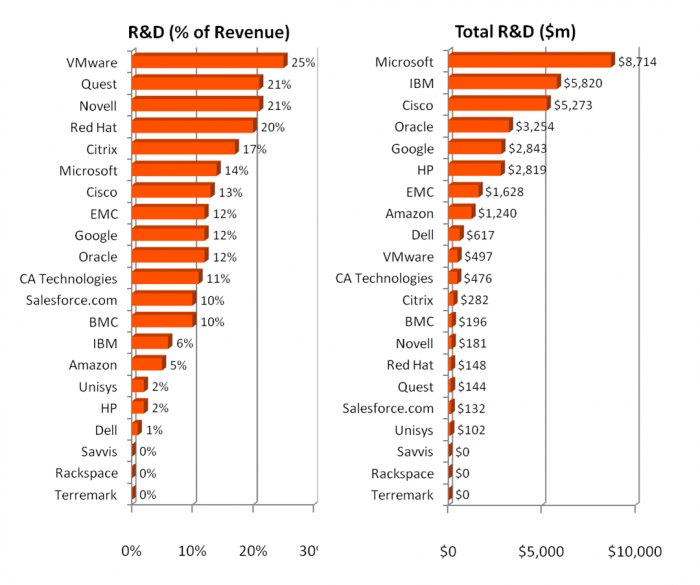I was pointed the other day to a chart on the Business Insider ‘Chart of the Day’ (@chartoftheday) showing the R&D expenditures for a handful of tech companies, evidence of Apple’s supposedly superior ‘innovation’ compared to four apparently randomly chosen tech companies.
On the surface, I thought it was an interesting idea, so I looked at R&D spending in companies that are actually related, in the virtualization and cloud computing space. With a little research on Google Finance, I put together the following chart:
While it is interesting to look at these numbers, and individual comparisons can be somewhat revealing, I don’t see a reliable correlation between technology innovation and R&D spending – either as a percentage of revenues, or an absolute amount.
I’ll just leave it here though. Feel free to comment on what you think this means.
Appendix: For the Inquisitive
If you are geek like me, you are probably wondering exactly what R&D means in context of publicly filed SEC documents. For the Generally Accepted Accounting Principles (GAAP), R&D is defined as follows
a. Research is planned search or critical investigation aimed at discovery of new knowledge with the hope that such knowledge will be useful in developing a new product or service (hereinafter “product”) or a new process or technique (hereinafter “process”) or in bringing about a significant improvement to an existing product or process.
b. Development is the translation of research findings or other knowledge into a plan or design for a new product or process or for a significant improvement to an existing product or process whether intended for sale or use. It includes the conceptual formulation, design, and testing of product alternatives, construction of prototypes, and operation of pilot plants. It does not include routine or periodic alterations to existing products, production lines, manufacturing processes, and other on-going operations even though those alterations may represent improvements and it does not include market research or market testing activities.
The source also has a number of useful examples of what is and is not, considered R&D. Of particular note, the following are not included in R&D costs:
- On-going efforts to refine, enrich, or otherwise improve upon the qualities of an existing product
- Adaptation of an existing capability to a particular requirement or customer’s need
- Legal work in connection with patent applications or litigation
- Intangibles that are purchased from others … that have alternative future uses
You may also want to check the data for yourself too. It all comes from the most recent annual reports, as recorded in Google Finance. I have included the data below, with links to the original Google Finance pages. Hopefully I have transcribed it correctly. Enjoy!
| Company | Symbol | Total Revenue ($m) | Total R&D ($m) | R&D (% of Revenue) |
| Microsoft | MSFT | 62,484 | 8,714 | 14% |
| IBM | IBM | 95,759 | 5,820 | 6% |
| Cisco | CSCO | 40,040 | 5,273 | 13% |
| Oracle | ORCL | 26,820 | 3,254 | 12% |
| GOOG | 23,651 | 2,843 | 12% | |
| HP | HPQ | 114,175 | 2,819 | 2% |
| EMC | EMC | 14,026 | 1,628 | 12% |
| Amazon | AMZN | 24,509 | 1,240 | 5% |
| Dell | DELL | 52,902 | 617 | 1% |
| VMware | VMW | 2,024 | 497 | 25% |
| CA Technologies | CA | 4,353 | 476 | 11% |
| Apple | AAPL | 15,700 | 464 | 3% |
| Citrix | CTXS | 1,614 | 282 | 17% |
| BMC | BMC | 1,911 | 196 | 10% |
| Novell | NOVL | 862 | 181 | 21% |
| Red Hat | RHT | 748 | 148 | 20% |
| Quest | QSFT | 695 | 144 | 21% |
| Salesforce.com | CRM | 1,306 | 132 | 10% |
| Unisys | UIS | 4,598 | 102 | 2% |
| Terremark | TMRK | 292 | 0 | 0% |
| Rackspace | RAX | 629 | 0 | 0% |
| Savvis | SVVS | 874 | 0 | 0% |

3 comments for “The Cost of Innovation in Virtualization and Cloud?”